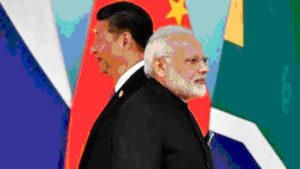Xi Jinping’s Strategic Miscalculation Spawns A Dangerous Himalayan Military Stalemate
17 Jan 2022
Thanks to the Xi Jinping-ordered aggression, India seems more determined than ever to work with like-minded states to prevent China from gaining pre-eminence in Asia

Narendra Modi and Xi Jinping
Yet another round of India-China military talks to defuse the almost 21-month-old border standoffs between rival forces has ended without any progress. This should come as no surprise: Stalling tactics, deception, information warfare and drawing out negotiations are integral to China’s negotiating strategy, so as to test the limits of the opponent’s position and help consolidate its own leverage.
Amid the brewing confrontation with India, China has stepped up its frenzied construction of warfighting infrastructure in the Himalayan borderlands. The speed and scale of its construction activity to build new permanent facilities extending from heliports to electronic warfare stations might suggest that it is preparing to launch a war at a time of its choosing.
China’s primary objective, however, is to win without fighting. This is in keeping with ancient military strategist Sun Zhu’s advice, “The ability to subdue the enemy without any battle is the ultimate reflection of the most supreme strategy.”
From building a bridge over Lake Pangong to constructing militarised villages and roads inside internationally recognised Bhutanese territory near India’s so-called chicken-neck, China is opening new pressure points against India. To pressure India to back down, it is also employing psychological operations, media manipulation and the spectre of war.
India, however, refuses to buckle under Chinese pressure. Since it discovered China’s territorial encroachments on Ladakh’s borderlands, India has more than matched Chinese military deployments. The Indian armed forces currently are at the highest level of operational readiness, according to Army chief General Manoj M Naravane.
To be sure, India remains locked in a very defensive posture vis-à-vis China. Militarily and diplomatically, China has created a situation in which it retains the initiative. While fending off Beijing’s political machinations, India has to be alert to the possibility that the People’s Liberation Army (PLA) could spring a new military surprise.
Meanwhile, the Chinese bridge over Pangong, by strengthening China’s offensive capability in the area, casts an unflattering light on India’s decision of less than a year ago to vacate the strategic Kailash Heights. The withdrawal from the Kailash Heights, which overlook the PLA’s Moldo garrison, was a Chinese New Year gift from India.
India also accepted Chinese-designed ‘buffer zones” in three separate Ladakh areas where PLA forces had intruded. The buffer zones have largely been established in territories that were under India’s patrolling jurisdiction.
Still, China refuses to roll back its intrusions from areas critical to Indian defences, including from the Depsang Y-Junction, which controls access to several areas. Although the Depsang issue predates the current crisis, China significantly deepened and broadened its encroachments in that sector in April-May 2020. Now, Beijing mocks India’s insistence on a return to the pre-April 2020 positions as “unreasonable and unrealistic”.
China’s encroachments on Bhutanese territory, meanwhile, threaten to open a military axis against India’s chicken-neck from a different direction than the route Indian forces blocked during the 2017 Doklam standoff. Known formally as the Siliguri Corridor, the chicken-neck is a narrow strip of land that connects the Indian mainland to the remote northeastern region.
By building roads along River Torsa through Bhutanese territory and by setting up militarised enclaves on Bhutan’s southwestern borderlands, China is seeking to place itself in a position to potentially cut off India’s northeast from the rest of the country in the event of a war. The Chinese construction activity violating Bhutanese territorial sovereignty is also aimed at undermining Bhutan’s security relationship with India and compelling Thimphu to yield to the longstanding Chinese demands in the 37-year-old border negotiations.
India faces a dilemma over how to deal with the threat China is seeking to mount by bringing some Bhutanese border areas under its occupation. These traditionally uninhabited areas may be of marginal value to Bhutan but they are of critical importance to Indian defences. Bhutan has refrained from uttering a word on the Chinese encroachments, as it hews to a policy of not saying anything publicly on the border disputes with China.
However, India, despite some missteps, has taken a firm and resolute stance against the Chinese encroachments on Indian borderlands by locking horns in tense military standoffs, despite the risk of a full-scale war. China’s stepped-up psy-ops and infowar to undermine India’s will to resist its aggression have achieved little. Indeed, General Naravane has declared that Indian forces will remain forward deployed until China agrees to implement a sequential process of disengagement, de-escalation and de-induction from all the confrontation sites.
As the Himalayan military crisis underscores, Chinese president Xi Jinping has displayed an increasing appetite for taking risks, with a publicly released US intelligence report saying his regime is seeking to “compel regional neighbours to acquiesce to Beijing’s preferences”. Xi’s muscular revisionism is apparently driven by his belief that China has a strategic window of opportunity that it must seize before it closes.
In addition to the territorial objectives, the aggression Xi launched against India has had geopolitical aims, including establishing China’s primacy in Asia. Xi believed that, if China used deception and surprise to catch India off-guard and create new territorial fait accompli, it would make smaller Asian states fall in line.
Xi’s strategic miscalculation, however, has been laid bare by the vigorous Indian military response. In fact, the multiple clashes with the battle-hardened Indian forces in 2020 made China realise that the PLA, with little combat experience since its disastrous 1979 invasion of Vietnam, must avoid further close combat. This is why Beijing persuaded India to accept buffer zones in three regions.
Thanks to the Xi-ordered aggression, India seems more determined than ever to work with like-minded states to prevent China from gaining pre-eminence in Asia. The aggression has also ensured that India will be a stumbling block to Xi’s plan to capture the Dalai Lama institution as a crucial final step to cement China’s hold on Tibet.
More fundamentally, Xi’s strategic miscalculation has spawned a dangerous Himalayan military stalemate. The Pentagon’s recent annual report on China said the PLA is bracing for a two-front scenario — “any escalation of border tensions with India, as well as preparing to support a Taiwan contingency”. Regardless of whether the current military crisis is defused or escalates to armed localised clashes, if not outright war, Xi has sown the seeds of a long-term conflict with India.
Courtesy: Firstpost

